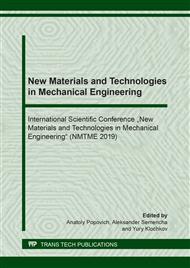[1]
M.O. Gushchina, O.G. Klimova-Korsmik, A.M. Vildanov, S.A. Shalnova, A.S. Tataru, E.A. Norman, Influence of the protective atmosphere on the structure and properties parts from titanium alloy Ti-6Al-4V produced by direct laser deposition, Journal of Physics: Conference Series (2018), 1109 (1), 012060.
DOI: 10.1088/1742-6596/1109/1/012060
Google Scholar
[2]
R.V. Mendagaliyev, O.G. Klimova-Korsmik, K.M. Medvedeva, A.A. Voropayev, A.D. Eremeev, I.A. Tsibulsky, E.A. Norman, Features of structure formation and properties at laser and arc surfacing from steel wire, Journal of Physics: Conference Series (2018), 1109 (1), 012040.
DOI: 10.1088/1742-6596/1109/1/012040
Google Scholar
[3]
T. DebRoy, H.L. Wei, J.S. Zuback, T. Mukherjee, J.W. Elmer, J.O. Milewski, A.M. Beese, A. Wilson-Heid, A. De, W. Zhang, Additive manufacturing of metallic components-process, structure and properties, Progress in Materials Science 92 (2018) 112-224.
DOI: 10.1016/j.pmatsci.2017.10.001
Google Scholar
[4]
S.A. Shalnova, O.G. Klimova-Korsmik, M.O. Sklyar, Influence of the roughness on the mechanical properties of ti-6al-4v products prepared by direct laser deposition technology, Solid State Phenomena 284 (2018), 312-318.
DOI: 10.4028/www.scientific.net/ssp.284.312
Google Scholar
[5]
M.O. Sklyar, O.G. Klimova-Korsmik, V.V. Cheverikin, Formation structure and properties of parts from titanium alloys produced by direct laser deposition, Solid State Phenomena 265 (2017), 535-541.
DOI: 10.4028/www.scientific.net/ssp.265.535
Google Scholar
[6]
I.A. Tsibulskiy, V.V. Somonov, R.S. Korsmik, M.O. Gushchina, A.D. Eremeev, The influence of technological parameters on the structure formation of aluminum alloys during direct deposition of wire, Journal of Physics: Conference Series (2018), 1109 (1), 012032.
DOI: 10.1088/1742-6596/1109/1/012032
Google Scholar
[7]
L.A. Magerramova, G.A. Turichin, Y.A. Nozhnitsky, O.G. Klimova-Korsmik, B.E. Vasiliev, M.E. Volkov, A.V. Salnikov, Peculiarities of additive technologies application in the production of gas turbine engine parts, Journal of Physics: Conference Series (2018), 1109 (1), 012051.
DOI: 10.1088/1742-6596/1109/1/012051
Google Scholar
[8]
V. Glukhov, G Turichin, O. Klimova-Korsmik, E. Zemlyakov, Quality management of metal products prepared by high-speed direct laser deposition technology, Key Engineering Materials 684 (2016) 461-467.
DOI: 10.4028/www.scientific.net/kem.684.461
Google Scholar
[9]
P.A. Golovin, A.M. Vildanov, K.D. Babkin, Distortion prevention of axisymmetric parts during laser metal deposition, Journal of Physics: Conference Series 1109 (1) (2018) 012065.
DOI: 10.1088/1742-6596/1109/1/012065
Google Scholar
[10]
A.D. Akhmetov, M.O. Sklyar, R.S. Korsmik, I.A. Tsibulskiy, Features of the Structure Formation at Laser and Laser-Arc Deposition from Aluminum Wire, Solid State Phenomena 284 (2018) 270-275.
DOI: 10.4028/www.scientific.net/ssp.284.270
Google Scholar
[11]
B. Wu, Z. Pan, D. Ding, D. Cuiuri, H. Li, J. Xu, J. Norrish, A review of the wire arc additive manufacturing of metals: properties, defects and quality improvement, Journal of Manufacturing Processes 35 (2018) 127–139.
DOI: 10.1016/j.jmapro.2018.08.001
Google Scholar
[12]
S.W. Williams, F. Martina, A. C. Addison, J. Ding, G. Pardal, P. Colegrove, Wire + Arc Additive Manufacturing, Materials Science and Technology 32(7) (2016) 641–647.
DOI: 10.1179/1743284715y.0000000073
Google Scholar
[13]
P.A. Golovin, A.M. Vildanov, K.D. Babkin, Optimization of high-speed direct laser deposition regime parameters in titanium blades production, Lecture Notes in Mechanical Engineering 9783319956299 (2019), 2475-2483.
DOI: 10.1007/978-3-319-95630-5_268
Google Scholar
[14]
G. Turichin, E. Zemlyakov, K.Babkin, S. Ivanov, A Vildanov, Laser metal deposition of Ti-6Al-4V alloy with beam oscillation, Procedia CIRP 74 (2018) 184-187.
DOI: 10.1016/j.procir.2018.08.090
Google Scholar
[15]
A. D. Polyanin, Handbook of linear partial differential equations for engineers and scientists. Chapman & Hall/CRC, Boca Raton–London (2002).
Google Scholar
[16]
A. P. Prudnikov, U. A. Brychkov, O. I. Marichev, Integrals and series. Vol.1. Elementary functions. Gordon and Breach Sci. Publ., New York, (1986).
DOI: 10.1201/9780203750643-2
Google Scholar


